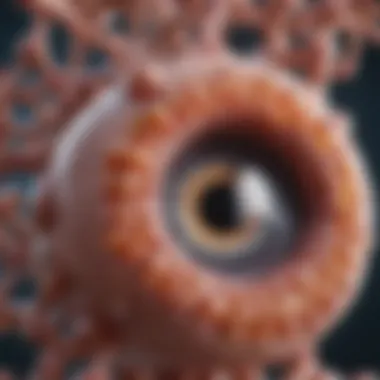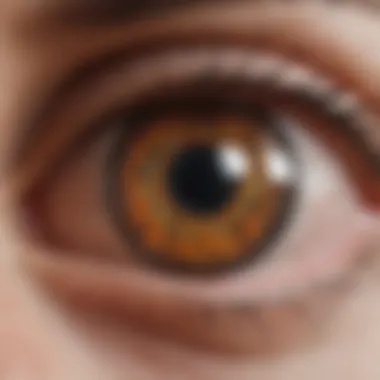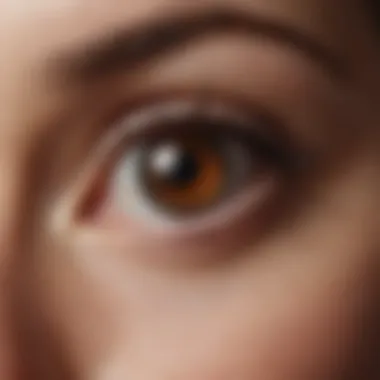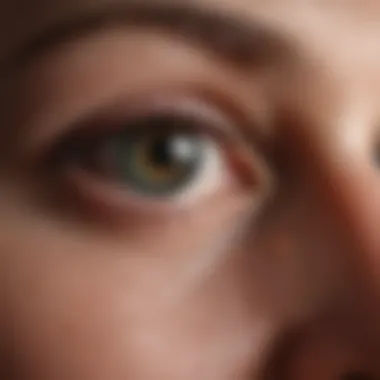Lipid Eye Treatment: Exploring Ocular Health


Intro
Lipid eye treatments represent a significant advancement in ocular health, addressing various disorders that stem from lipid imbalances. Understanding the intricate roles that lipids play in maintaining eye function is crucial. This article will explore key concepts, current research trends, and the implications of lipid treatments in clinical practice.
Key Concepts
Definition of the Main Idea
At its core, lipid eye treatment refers to therapeutic practices targeting various lipids to improve eye health. Lipids are organic molecules that are essential in cellular structure and function. In the eye, they are fundamental in forming the tear film, maintaining moisture, and providing protection against pathogens.
Overview of Scientific Principles
The eye relies on a delicate balance of lipids. A disruption in this balance can lead to conditions such as dry eye syndrome or meibomian gland dysfunction. Lipids, specifically phospholipids and triglycerides, play a vital role in tear film stability and lipid distribution on the ocular surface.
New research indicates that lipid metabolism is not merely a supporting role but is central to eye health. Studies show that oxidative stress and inflammation can affect lipid composition, leading to degenerative conditions. Thus, targeting lipid pathways could offer fresh avenues for treatment.
Current Research Trends
Recent Studies and Findings
Investigations into lipid eye treatments have revealed promising techniques. For example, therapeutic lipids are being examined for their potential to ameliorate symptoms of dry eye disease. A study showcased the efficacy of Omega-3 fatty acids in improving tear production and quality.
Additionally, research highlights the relationship between lipid profiles and ocular diseases, such as diabetic retinopathy. By addressing lipid abnormalities, significant improvement in patient outcomes has been noted.
Significant Breakthroughs in the Field
One notable breakthrough involves the use of lipid-based nanoparticles for drug delivery to the eye. This method enhances the bioavailability of therapeutics, potentially transforming how ocular conditions are managed. Researchers are also investigating the implications of dietary lipids on eye health, opening new doors for preventive measures.
"By focusing on lipid metabolism, we can not only treat existing conditions but also develop preventive strategies for age-related eye disorders."
"By focusing on lipid metabolism, we can not only treat existing conditions but also develop preventive strategies for age-related eye disorders."
Understanding Lipids in Ocular Health
The topic of lipids in ocular health is essential for understanding both the physiological and pathological aspects of eye care. Lipids play a crucial role in maintaining the structural integrity and functionality of ocular tissues. They are not merely energy sources; rather, they have significant biochemical roles in cellular communication and metabolic processes. In the context of eye treatments, a firm grasp of lipid function can illuminate the development of new therapeutic approaches aimed at alleviating various ocular disorders.
Prologue to Lipids
Lipids are a group of organic compounds that are insoluble in water but soluble in organic solvents. They include fats, oils, waxes, and certain vitamins. In the eye, lipids are integral to several processes. They help form cell membranes and are involved in signaling pathways. Their presence is vital for proper cellular function. Abnormal lipid metabolism can lead to several ocular conditions, such as dry eye disease and meibomian gland dysfunction, which negatively impact vision and quality of life.
Types of Lipids and Their Functions
Various types of lipids serve unique functions in the human body, particularly in ocular health. Key categories include:
- Phospholipids: These are crucial for structural integrity and signaling. They form the lipid bilayer of cell membranes, contributing to cellular organization.
- Cholesterol: Often referred to as a sterol lipid, it is essential for maintaining membrane fluidity and serves as a precursor for steroid hormones.
- Triglycerides: These lipids store energy but also have importance in the tear film, helping to prevent evaporation.
- Fatty Acids: They are the building blocks of various lipids and can be classified as saturated or unsaturated, impacting their physical properties and roles in inflammation.
Understanding these types enhances knowledge about their functions in eye health, influencing treatment options.
Role of Lipids in Tear Film Stability
The tear film is a complex structure that consists of an aqueous layer, a mucin layer, and a lipid layer. The lipid layer plays a critical role in reducing tear evaporation, thus maintaining ocular moisture.
Deficiency in lipids can lead to an unstable tear film, often resulting in symptoms of dry eye disease. The meibomian glands produce lipids that compose this layer; hence, dysfunction in these glands can severely impair tear film stability. Regular lipid metabolism ensures that enough lipids are produced to maintain this barrier for healthy vision. Understanding the intricacies of lipid functions can aid in better clinical interventions when addressing dry eye syndromes.
"Lipids are not just fat; they are essential components of health, particularly in ocular physiology. Their role in tear film stability cannot be overstated."
"Lipids are not just fat; they are essential components of health, particularly in ocular physiology. Their role in tear film stability cannot be overstated."
This understanding is crucial for developing effective lipid-based treatments that restore the balance and function of the tear film, enhancing ocular health.
Lipid Disorders and Ocular Implications
Lipid disorders play a crucial role in ocular health, impacting various functions and systems that maintain eye integrity and comfort. Understanding these disorders is essential for developing effective treatment strategies. Various conditions related to lipid metabolism can compromise tear film stability and contribute to dry eye disease, among other issues. This section details the significance of lipid disorders and their implications on vision, illustrated through specific disorders and their physiological impact.
Understanding Dry Eye Disease


Dry eye disease (DED) is a multifactorial condition that significantly affects the quality of life. It arises when the eye does not produce enough tears, or when the tears evaporate too quickly. Lipids in the tear film are vital for reducing evaporation and maintaining moisture on the ocular surface. When lipid levels are low, this can escalate dry eye symptoms, such as irritation and discomfort. Understanding the connection between lipid metabolism and dry eye disease is essential for both diagnosis and treatment.
Common symptoms of dry eye disease include:
- Burning sensation in the eyes
- Red eyes
- Sensitivity to light
- Difficulty in focusing
- Watery eyes (as a reflex response)
Meibomian Gland Dysfunction
Meibomian gland dysfunction (MGD) is one of the leading causes of dry eye disease. These glands, located within the eyelids, are responsible for secreting lipids into the tear film. Insufficient lipid production leads to compromised tear quality and stability. Inflammation and blockage of these glands can further exacerbate symptoms. Maintaining the health of the meibomian glands is, therefore, a focal point in treating eye disorders.
Strategies for managing MGD may include:*
- Warm compresses to open blocked glands
- Lipid-based eye drops to restore natural moisture
- Regular eyelid hygiene to prevent inflammation
Impact of Lipid Deficiency on Vision
Lipid deficiency affects not just comfort but can also deteriorate visual quality. The stability of the tear film is critical for clear vision; any disruption can lead to fluctuations in vision. Moreover, chronic lipid deficiency may result in corneal damage, leading to further complications. It is essential to realize that addressing lipid deficiencies could offer a pathway to improve overall ocular health.
"Recent studies indicate that enhancing lipid levels in the tear film can significantly improve symptoms of dry eye disease and may lead to better visual outcomes."
"Recent studies indicate that enhancing lipid levels in the tear film can significantly improve symptoms of dry eye disease and may lead to better visual outcomes."
Mechanisms of Lipid Eye Treatments
Lipid eye treatments are essential for addressing various ocular conditions related to lipid deficiency. Understanding the mechanisms behind these treatments is crucial for both the effectiveness and advancement of ocular health interventions. The integration of lipid-based therapies aims to restore balance to the tear film, promote healing, and enhance overall comfort for patients. The analysis of mechanisms gives insight into how these treatments can be tailored to address specific dysfunctions in eye health.
Biochemical Pathways Involved
Biochemical pathways play a fundamental role in the way lipid treatments operate within the ocular system. The lipids present in the tear film contribute significantly to maintaining ocular surface homeostasis. One important pathway involves the metabolism of essential fatty acids, such as omega-3 and omega-6, which are precursors for bioactive lipids. These bioactive lipids often modulate inflammatory responses and support the repair processes in the eye.
When lipids are introduced through treatments like eye drops or other formulations, they impact the composition and stability of the tear film. They can influence biochemical signaling pathways, promoting the function of the meibomian glands, which are responsible for lipid secretion. Disruption in these pathways can lead to impaired lipid formation, which exacerbates conditions like dry eye disease. Therefore, treatments that effectively engage these pathways can restore normal functioning and alleviate symptoms.
Pharmacokinetics of Lipid-Based Therapies
Pharmacokinetics refers to how a drug is absorbed, distributed, metabolized, and excreted in the body. For lipid-based therapies, understanding pharmacokinetics is vital for optimizing the delivery of lipids to the targeted ocular tissues.
Lipid-based formulations can vary widely. Some may utilize enhanced absorption techniques, while others focus on sustained release measures. This attribute is critical to ensure that lipids maintain therapeutic levels for as long as possible. For instance, using nanoparticles or liposomes can protect lipids from degradation, allowing for prolonged effects in the ocular environment. Proper assessment of these pharmacokinetic characteristics can inform clinicians on how best to administer these treatments and what expected outcomes might be.
Interaction with Ocular Microbiome
The ocular microbiome—the community of microorganisms residing on the eye surface—plays a significant role in eye health. Lipid treatments may interact with this microbiome, influencing its composition and function, which could have downstream effects on ocular disease.
Research shows that certain lipid formulations can enhance the growth of beneficial bacteria while suppressing pathogenic ones. This balance is crucial for preventing infections and maintaining homeostasis in the eye. Furthermore, the health of the ocular microbiome is directly related to the immune responses of the eye. Lipid treatments that encourage a healthy microbiome could potentially improve overall eye health and reduce occurrences of diseases.
"Understanding the interactions between lipid treatments and the ocular microbiome opens new avenues for the development of therapeutic strategies that are less just focused on symptom relief but rather aim at restoring the natural balance of eye health."
"Understanding the interactions between lipid treatments and the ocular microbiome opens new avenues for the development of therapeutic strategies that are less just focused on symptom relief but rather aim at restoring the natural balance of eye health."
Current Clinical Applications
Current clinical applications of lipid eye treatments underline the significant role lipids play in managing various ocular conditions. These treatments often focus on restoring lipid balance in the eye, crucial for tear film stability and overall ocular health. Understanding these applications enhances both treatment efficacy and patient outcomes. Here, we explore three prominent applications in the field: lipid-based eye drops, ocular inserts and implants, and innovations in lipid formulations.
Lipid-Based Eye Drops
Lipid-based eye drops represent one of the most significant advancements in ocular therapeutics. Unlike conventional aqueous drops, these formulations are designed to more closely mimic the natural composition of tears. They work to supplement the lipid layer of the tear film, preventing evaporation and maintaining moisture on the ocular surface.
The efficacy of lipid-based eye drops is evident in their quick action and prolonged relief from dry eye symptoms. Brands like Systane and Refresh offer various lipid-containing products that have gained considerable attention. They have become a staple in managing conditions such as evaporative dry eye disease and meibomian gland dysfunction.
Benefits include:
- Improved Comfort: Many patients report increased comfort and prolonged symptom relief.
- Reduced Frequency of Application: Patients often find they need to use these drops less frequently due to longer-lasting hydration.
- Enhanced Tear Stability: These droplets help stabilize the tear film, decreasing eye irritation.
Ocular Inserts and Implants
Ocular inserts and implants are another innovative application of lipid treatments. This method provides a sustained release of medication directly to the ocular surface, overcoming some limitations of traditional eye drops.


Ocular inserts, like those made by Allergan, have molcules that release lipid-based medications over extended periods. This strategic delivery system significantly enhances patient adherence to treatment plans, reducing the burden of frequently applying drops.
Key advantages of ocular inserts include:
- Extended Release: These help maintain therapeutic levels of medication in the eye without the frequent application.
- Improved Bioavailability: Inserts can enhance the absorption of lipophilic compounds into the ocular tissues.
- Targeted Therapy: Medical professionals can administer specific doses directly to the eye, minimizing systemic side effects.
Innovations in Lipid Formulations
Innovations in lipid formulations continue to emerge within the ocular treatment realm. The development of new lipid-based delivery systems enhances the potential for treating ocular diseases more effectively. Researchers are exploring various lipid compositions to optimize their formulations, introducing new combinations of oils and emulsifiers that improve stability.
Some notable advancements include:
- Nanoemulsions: These smaller droplets improve penetration and spreadability across the ocular surface.
- Smart Delivery Systems: Technologies that respond to the eye's state, releasing medication based on real-time needs.
- Hybrid Formulations: Combining lipids with hydrophilic agents to provide both hydration and lipid support.
The prospects for lipid treatments in ocular health continue to grow, with innovations aimed at resolving long-standing challenges in delivery and patient compliance.
The prospects for lipid treatments in ocular health continue to grow, with innovations aimed at resolving long-standing challenges in delivery and patient compliance.
In summary, the clinical applications of lipid eye treatments are revolutionizing the management of ocular health. They provide effective solutions to common eye issues, enhancing the quality of life for many patients. Continued research and development in this field promise even more effective treatments in the future.
Research and Development Trends
Research and development trends regarding lipid eye treatment are essential for advancing our understanding and management of ocular health. As we analyze this topic, the various elements that emerge are noteworthy. The advancements in therapies depend on rigorous scientific exploration and a commitment to improving patient outcomes. These trends not only include the investigation of new treatment modalities but also highlight an inclusive approach that integrates diverse fields such as biochemistry and ocular pharmacology.
Emerging Therapies and Technologies
In recent years, there have been exciting developments in emerging therapies and technologies in lipid-based treatments. Researchers are increasingly focusing on lipid-based formulations that aim to enhance tear film stability and reduce symptoms of dry eye disease. Novel technologies such as nanotechnology are proposing new delivery systems for lipid formulations. These systems can improve the bioavailability of active components by allowing them to penetrate deeper into ocular tissues.
Some promising lipid therapies currently under investigation include:
- Lipid Emulsion Solutions: These consist of various lipid blends that provide moisture and help restore tear film integrity.
- Micronized Lipid Suspension: This formulation enhances the ocular surface and promotes healing of damaged epithelial cells.
- Intravitreal Lipid Injections: These are designed for patients with specific retinal diseases, aiming to deliver lipids directly where they are most needed.
These therapies may signify a shift toward more effective treatments, making the path forward very promising for patients suffering from ocular disorders.
Preclinical and Clinical Trial Insights
As emerging therapies develop, preclinical and clinical trials offer critical insights into their efficacy and safety. Current studies are investigating various aspects of lipid eye treatments. They often assess dose-response relationships, safety profiles, and mechanisms of action, all contributing to the understanding of how lipids interact with ocular tissues.
Preclinical studies frequently utilize animal models to simulate human eye conditions. Successful findings often pave the way to clinical trials. Observations made during these trials can tell us if these therapies can improve patient quality of life. Moreover, long-term follow-up during these studies helps in observing any potential side effects or complications arising from the treatments.
To illustrate this phase, consider the Lipid-Based Eye Drops study. Initial findings noted improved tear film metrics and reduced inflammation markers in participants, indicating that lipid-based approaches hold promise.
Challenges in Research and Development
Despite the positive trajectory in lipid eye treatment research, several challenges persist. Firstly, the variability in individual responses to lipid therapies complicates regulatory approval processes. Different patients exhibit unique biological reactions, which makes standardizing treatments more difficult.
Additionally, funding for ongoing research can be inconsistent. While some pharmaceutical companies invest significantly, others are hesitant due to perceived risks. This lack of investment can stall innovative ideas before they reach implementation.
Lastly, there is the challenge of translating laboratory findings into practical applications. Often, the promising results seen in preclinical research do not yield similar success in human trials. Thus, a deeper investigation is needed to bridge the gap between bench and bedside.
"Innovations in lipid research have the potential to transform the way we approach ocular health, but persistent challenges must be addressed to fully realize this potential."
"Innovations in lipid research have the potential to transform the way we approach ocular health, but persistent challenges must be addressed to fully realize this potential."
In summary, the trends in research and development concerning lipid eye treatment reveal a complex landscape filled with potential, challenges, and the need for continued investment. The fascinating interplay of emerging therapies, trial insights, and inherent obstacles will shape the future of ocular therapeutics. This ongoing research is crucial for advancing patient care and enhancing the overall efficacy of lipid-based treatments.
Culmination
Understanding the significance of research and development trends in lipid eye treatments highlights the commitment to improving ocular health. Success in this field hinges on collaboration among researchers, healthcare providers, and patients to drive forward innovations and create effective treatments.
Patient Considerations and Accessibility
Patient considerations and accessibility in lipid eye treatments are crucial elements that influence both clinical outcomes and the broader acceptance of these therapies. Understanding how patients perceive and utilize these treatments can provide insights into their efficacy, safety, and overall satisfaction. Accessibility is vital to ensure that advancements in lipid therapies reach those who need them most, including individuals experiencing disorders such as dry eye disease.
Efficacy and Safety Profile


When introducing any new therapy, the efficacy and safety profile must be clearly established. Lipid eye treatments have shown promise in managing conditions linked to lipid imbalance. For example, studies have reported beneficial effects of lipid-based eye drops on improving tear film stability. These improvements can alleviate symptoms of dryness and irritation, raising the quality of life for patients. However, the potential risks from side effects must also be meticulously evaluated.
"Establishing confidence in the safety and efficacy of lipid treatments shapes patient adherence and overall success."
"Establishing confidence in the safety and efficacy of lipid treatments shapes patient adherence and overall success."
Regular monitoring and comprehensive clinical trials help build a robust body of evidence regarding these profiles. This information plays a pivotal role in informing healthcare professionals and patients about what to expect from these treatments.
Patient Education and Awareness
Patient education is fundamental for maximizing treatment outcomes. Knowledgeable patients are more likely to follow prescribed regimens and report adverse effects accurately, allowing for timely interventions. Informative resources should outline how lipid therapies work, the types of conditions they treat, and the expected benefits and risks.
Effective educational materials can include:
- Digital Platforms: Websites, online forums, and social media posts that discuss lipid therapies and share patient experiences.
- Printed Materials: Brochures or pamphlets distributed in clinics, explaining the role of lipids in ocular health and detailing treatment options.
- Workshops and Webinars: Live sessions led by experts can address patients’ concerns and improve understanding.
Increased awareness among patients can drive demand for these therapies and encourage them to advocate for their own health needs.
Access to Lipid Treatments
Access to lipid treatments varies significantly based on geographical location, health insurance coverage, and healthcare infrastructure. Barriers to access can compound health disparities, particularly for populations that may benefit the most from lipid therapies.
To enhance accessibility, several strategies should be considered, such as:
- Improving Insurance Coverage: Advocating for wider insurance acceptance of lipid-based therapies to alleviate financial burdens on patients.
- Telehealth Services: Utilizing telemedicine can provide patients in remote areas with easier access to specialists.
- Community Health Initiatives: Local health campaigns can promote awareness and accessibility for underrepresented populations.
Efforts to improve access are vital to ensure that lipid eye treatments are available to all patients who require them, ultimately leading to better ocular health outcomes.
Future Perspectives
The discourse surrounding lipid eye treatments is progressing rapidly, highlighting crucial developments and potential advancements in ocular health. Understanding future perspectives in this field is essential for both the scientific community and patients. These insights shape the trajectory of research and clinical applications, and they also illuminate the road ahead. The consideration of breakthroughs, technological integration, and vision restoration is pivotal in ensuring effective therapies for various ocular conditions.
Potential Breakthroughs in Lipid Research
In recent years, there has been notable interest in lipid research. New methodologies are providing deeper insights into lipid metabolism and its impact on ocular health. For example, identifying specific lipid types involved in tear film stability could lead to developments in targeted therapies. These discoveries might not only enhance treatment efficacy but also reduce potential side effects associated with generalized therapies.
Moreover, breakthroughs such as novel lipid formulations or delivery systems have emerged from research initiatives. These innovations could ensure optimal absorption and effectiveness of lipid-based medications.
Integration of Biotechnological Solutions
The integration of biotechnological solutions represents a transformative shift in lipid eye treatment strategies. Advancements in biotechnology provide opportunities to develop more personalized therapies. Using genetic or proteomic profiles, treatments could be customized to an individual's unique lipid metabolism. This precision medicine approach has the potential for significant improvement in treatment outcomes, providing immediate benefits for patients suffering from ocular disorders.
Additionally, biotechnological innovations such as stem cell therapies may hold promise for regenerating damaged ocular tissues. Ongoing research is critical in unveiling these possibilities, which require extensive development and trials but could revolutionize treatment paradigms in the long run.
Vision Restoration and Restoration Technologies
The quest for restoration technologies continues to be at the forefront of ocular research. Current developments aim not just to treat conditions, but also to restore sight. Lipid-based therapies could play a role in supporting neural cells in the retina, thus potentially reversing damage caused by various diseases.
Moreover, merging lipid treatments with other technologies, like gene therapy, may enhance the viability and efficacy of vision restoration methods. Utilizing lipid formulations in gene delivery systems could facilitate the targeted transport of corrective genetic material directly to ocular cells, fostering recovery and function.
The future of lipid eye treatments is not merely an advancement in technology; it signifies a paradigm shift in how ocular health is approached and treated.
The future of lipid eye treatments is not merely an advancement in technology; it signifies a paradigm shift in how ocular health is approached and treated.
Epilogue
In this article, the discussion of lipid eye treatments showcases their essential role in maintaining ocular health. The insights gained emphasize the complexity of how lipids affect various functions of the eye, including tear film stability and overall eye moisture. This understanding is pivotal in the context of eye disorders such as dry eye disease and Meibomian gland dysfunction.
Summary of Key Findings
The key findings illustrate critical aspects of lipid function and treatment modalities. Notably, lipids ensure adequate tear production, which is vital for eye comfort and protection. The evidence presented highlights that lipid-based therapies, such as specific eye drops and implants, have been significantly beneficial in recent years.
- Lipid-based eye drops serve to replenish the tear film, providing immediate relief to sufferers of dry eye conditions.
- Ocular inserts offer prolonged release of therapeutic agents directly to the eye, addressing chronic conditions effectively.
- Innovative formulations continue to emerge, enhancing the efficacy and safety of lipid treatments.
Moreover, the section on future perspectives underlines the unmet needs that exist within ocular therapeutics. As lipid research continues to progress, there exists a compelling opportunity to refine these treatments further, potentially improving patient outcomes in a field that has wide-ranging implications for quality of life.
Call for Continued Research
It is clear that continued research is of utmost importance in advancing lipid eye treatments. As we stand at the intersection of innovation and clinical practice, the potential breakthroughs in lipid research present a pathway to tackle ocular diseases more effectively. Areas that require focused investigation include:
- The impact of personalized medicine in lipid therapy.
- Comprehensive studies assessing the long-term safety and efficacy of existing treatments.
- Exploring the interplay between lipids and the ocular microbiome to better understand underlying mechanisms of eye health.
A multidisciplinary approach that includes biochemistry, pharmacology, and clinical practice will deepen our understanding and guide future developments. With the increasing prevalence of ocular disorders, especially among an aging population, the need for efficacious lipid-based treatments has never been more urgent.







